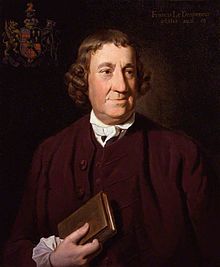Returning to Franklin and Dashwood
I’m returning to the question I started the month with, on the relationship between Benjamin Franklin and Sir Francis Dashwood, known after 1763 as the Baron le Despencer (shown here).
More specifically, did Franklin participate in activities of Dashwood’s “Monks of Medmenham Abbey,” dubbed by nineteenth-century chroniclers as a “Hellfire Club”?
In 1926 Phillips Russell wrote wishfully about their relationship in The True Benjamin Franklin:
It’s striking that in 1974 the British author Geoffrey Ashe wrote of Franklin:
That meant it became easier to imagine Franklin among the Medmenham Monks, enjoying wine, women, and song in a highly decorated cave. But did that happen?
Into the vacuum of evidence stepped the British journalist Donald McCormick, bearing quotations about “Brother Benjamin of Cookham” and Franklin writing of the “classical design, charmingly reproduced by the Lord le Despencer at West Wycombe, whimsical and puzzling…as evident below the earth as above it.”
McCormick cleverly avoided saying he’d found direct evidence Franklin participated in Despencer’s revels, such as a Hellfire Club membership list. Instead, he laid down indirect pointers for readers to piece together with him. But, as was his pattern over many books, McCormick made all that up.
Where does that leave us when it comes to Franklin and Despencer? We know there are many holes in the historic record. We know some of those holes were created by people destroying documents about illicit or simply unsavory behavior. We know in-person interactions don’t necessarily leave a paper trail.
Must we therefore say that though there’s no documentary evidence that Franklin participated in the activities of the Monks of Medmenham Abbey when he came to Britain in 1757, or even knew Sir Francis Dashwood until years later, we just can’t be sure, so it’s an open question?
I think we can come closer to an answer with the documentation that does survive.
TOMORROW: The beginnings of a beautiful friendship.
More specifically, did Franklin participate in activities of Dashwood’s “Monks of Medmenham Abbey,” dubbed by nineteenth-century chroniclers as a “Hellfire Club”?
In 1926 Phillips Russell wrote wishfully about their relationship in The True Benjamin Franklin:
In Lord le Despencer Franklin found the kind of man which he most looked up to. His lordship was elegantly wicked, and so was possessed of a quality which Franklin admired with his whole heart. There can be little doubt that membership in the Hell Fire Club, though perhaps not accepted, would have enticed him irresistibly. We already know how he loved clubs and good company.But there was no actual evidence Russell could point to.
It’s striking that in 1974 the British author Geoffrey Ashe wrote of Franklin:
He sounds a surprising person to meet in this setting, but he was more anti-clerical, heavier in his drinking, and laxer in his sexual habits and outlook than American hagiography cares to admit.Ashe appears to have been reacting to an older public memory of Franklin as the embodiment of his “Way to Wealth” essay—sober, self-regulated, and above all diligent. But by that time, as the earlier quotation shows, the American image of Franklin was already shifting to the sly, womanizing wit we admire today. The admiration stayed the same; what we as a culture were looking for in a Founder changed.
That meant it became easier to imagine Franklin among the Medmenham Monks, enjoying wine, women, and song in a highly decorated cave. But did that happen?
Into the vacuum of evidence stepped the British journalist Donald McCormick, bearing quotations about “Brother Benjamin of Cookham” and Franklin writing of the “classical design, charmingly reproduced by the Lord le Despencer at West Wycombe, whimsical and puzzling…as evident below the earth as above it.”
McCormick cleverly avoided saying he’d found direct evidence Franklin participated in Despencer’s revels, such as a Hellfire Club membership list. Instead, he laid down indirect pointers for readers to piece together with him. But, as was his pattern over many books, McCormick made all that up.
Where does that leave us when it comes to Franklin and Despencer? We know there are many holes in the historic record. We know some of those holes were created by people destroying documents about illicit or simply unsavory behavior. We know in-person interactions don’t necessarily leave a paper trail.
Must we therefore say that though there’s no documentary evidence that Franklin participated in the activities of the Monks of Medmenham Abbey when he came to Britain in 1757, or even knew Sir Francis Dashwood until years later, we just can’t be sure, so it’s an open question?
I think we can come closer to an answer with the documentation that does survive.
TOMORROW: The beginnings of a beautiful friendship.


No comments:
Post a Comment